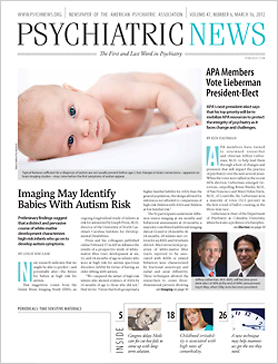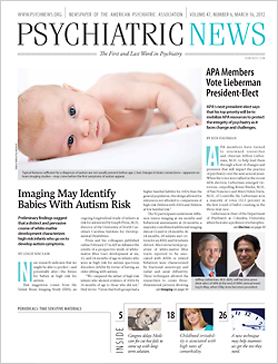Test May Diagnose Major Depression
Researchers at Massachusetts General Hospital and Harvard Medical School have examined the diagnostic performance of a multiassay, serum-based test for major depressive disorder (MDD) called MDDScore. Serum levels of nine biomarkers in peripheral blood were measured in two samples of MDD patients, and one sample of nondepressed control subjects. The biomarkers were selected on the basis of previous exploratory analyses in separate patient/control samples. Individual assay values were combined mathematically to yield the MDDScore. A “positive” test (consistent with the presence of MDD) was defined as an MDDScore of 50 or greater.
In a pilot study, 36 MDD patients were recruited along with 43 nondepressed subjects. In this sample, the test demonstrated a sensitivity and specificity of 91.7 percent and 81.3 percent, respectively, in differentiating between the two groups. A replication study involved 34 MDD subjects, and yielded nearly identical sensitivity and specificity.
“The results of the present study suggest that this test can differentiate MDD subjects from nondepressed controls with adequate sensitivity and specificity. Further research is needed to confirm the performance of the test across various age and ethnic groups, and in different clinical settings,” they wrote.
The studies were funded by Ridge Diagnostics.
Antidepressants Decrease Suicidal Thoughts, Actions
Researchers in Chicago, Miami, and New York recently analyzed longitudinal MDD data from 12 adult, four geriatric, and four youth randomized, controlled trials of fluoxetine and from 21 adult trials of venlafaxine, which included the records of 9,185 patients. Those taking fluoxetine included 2,635 adult patients, 960 geriatric patients, and 708 youth. Those taking venlafaxine included 2,421 adults taking immediate-release venlafaxine and 2,461 adults taking extended-release venlafaxine.
Fluoxetine and venlafaxine decreased suicidal thoughts and behavior for adult and geriatric patients, a protective effect mediated by decreases in depressive symptoms with treatment. For youth, no significant effects of treatment on suicidal thoughts and behavior were found, although depression responded to treatment. No evidence of increased suicide risk was observed in youth receiving active medication.
“To our knowledge,” wrote the researchers, “this is the first research synthesis of suicidal thoughts and behavior in depressed patients treated with antidepressants that examined the mediating role of depressive symptoms using complete longitudinal person-level data from a large set of published and unpublished studies.”
The study was supported by grants from the National Institute of Mental Health (NIMH) and the Agency for Healthcare Research and Quality. Data were supplied by NIMH (Treatment for Adolescents with Depression Study) and by Wyeth and Eli Lilly.
Prenatal, Perinatal Risk Factors Studied in Adult ADHD
Little is known about risk factors for attention deficit/hyperactivity disorder (ADHD) persisting beyond adolescence. A recent study from researchers at the K.G. Jebsen Center for Research on Neuropsychiatric Disorders at the University of Bergen in Norway investigated the association between pregnancy and birth complications and ADHD in adulthood.
They used data from the Medical Birth Registry of Norway to compare prenatal and perinatal risk factors among 2,323 adults approved for medical treatment for ADHD, with the remaining population born during the same years, 1967 to 1987, and surviving into adulthood (n=1,170,073). Preterm (less than 37 weeks gestation) and extremely preterm birth (less than 28 weeks of gestation) were associated with 1.3-fold and 5-fold increased risk of ADHD, respectively. Five-minute Apgar scores less than 4 and less than 7 were associated with 2.8- and 1.5-fold increased risk of persisting ADHD, respectively. Low birth weights also increased the risk of ADHD. Maternal epilepsy and offspring oral cleft occurred more frequently among adult ADHD patients.
“This is the first population-based study of pre- and perinatal risk factors in adults with ADHD,” wrote the researchers. “We show that low birth weight, preterm birth, and low Apgar scores increase the risk of ADHD, persisting up to 40 years after birth. The increased risk of ADHD related to oral cleft and to maternal epilepsy warrants further investigation to explore possible causal mechanisms.”
This work was supported by the Research Council of Norway, University of Bergen, and Western Norway Regional Health Authority.
Intensive Sleep Retraining May Be Key to Resolving Insomnia
Intensive sleep retraining (ISR) may help insomniacs get the rest they need. Sleep researchers at Flinders University of South Australia studied 79 individuals (23 males, 56 females, mean age 40.9) with chronic sleep-onset insomnia, with and without sleep-maintenance difficulties. The participants, who had no other sleep disorders or major psychiatric illnesses, were randomly assigned to intensive sleep retraining (ISR), stimulus control therapy (SCT), ISR plus SCT, or a control group.
ISR consisted of 25 hours divided into 50 half-hourly sleep-onset opportunities. Within each treatment trial, the opportunity for sleep onset was limited to a 20-minute period, with the trial stopping if sleep onset had not occurred by this time. For those trials in which sleep was initiated, three consecutive minutes of sleep were permitted prior to being awakened. Upon awakening, treatment participants rated their perception of whether sleep onset had occurred and were then provided with information as to whether sleep onset had or had not occurred. ISR was conducted in a sleep laboratory and started at 10:30 p.m. after a restricted, five-hour sleep the previous night.
SCT consisted of five weekly appointments with a psychologist, focusing on reassociating the bed and bedroom with sleep and establishing a consistent sleep schedule.
Treatment response was assessed with a sleep diary, activity monitoring, and questionnaire measures. The active treatment groups (ISR, SCT, ISR+SCT) all resulted in significant improvements in sleep onset latency and sleep efficiency, with moderate to large effect sizes from pre- to post-treatment. Wake time after sleep onset decreased significantly in the SCT and ISR+SCT groups. Total sleep time increased significantly in the ISR and ISR+SCT treatment groups. Participants receiving ISR or ISR+SCT experienced rapidly improved sleep onset latency and total sleep time during treatment, suggesting an advantage of rapid improvements in sleep in response to ISR.
The researchers concluded that this intensive conditioning treatment for chronic insomnia can produce rapid improvements in sleep, daytime functioning, and psychological variables, and that adding ISR to traditional interventions seems to result in a superior treatment response. “Further investigations into determining appropriate treatment recipients and alternative forms of implementation of such a brief conditioning treatment are warranted,” they wrote.

